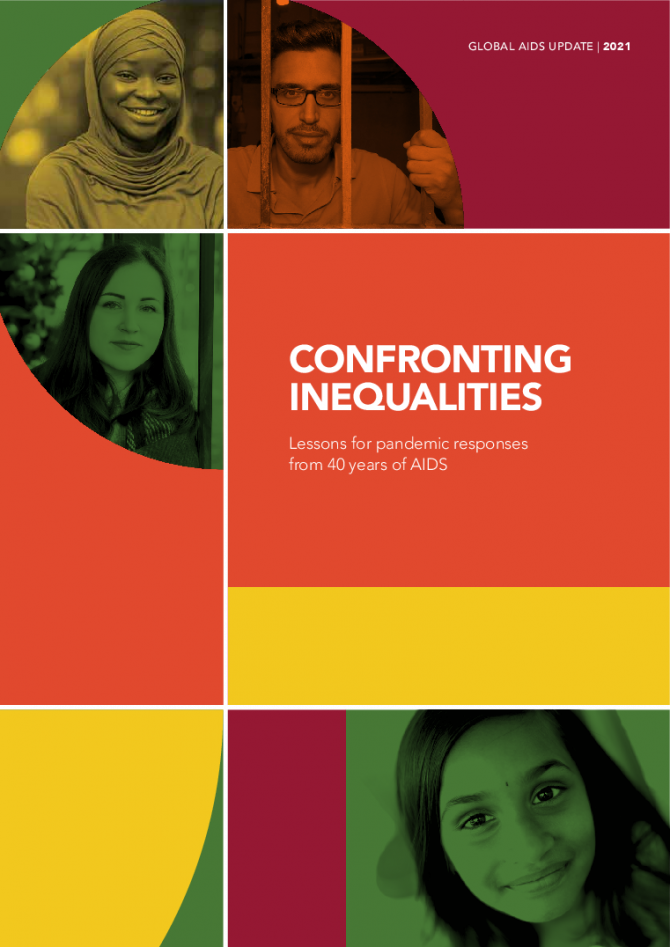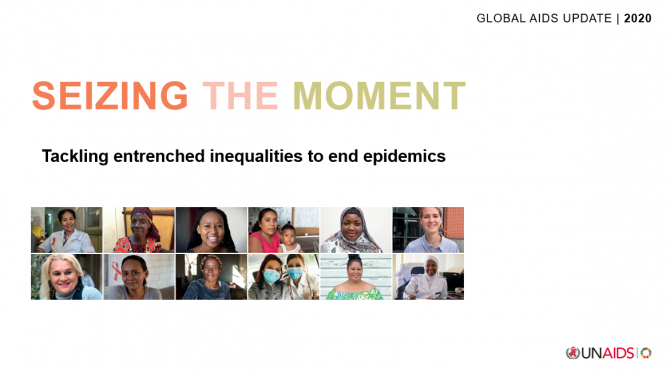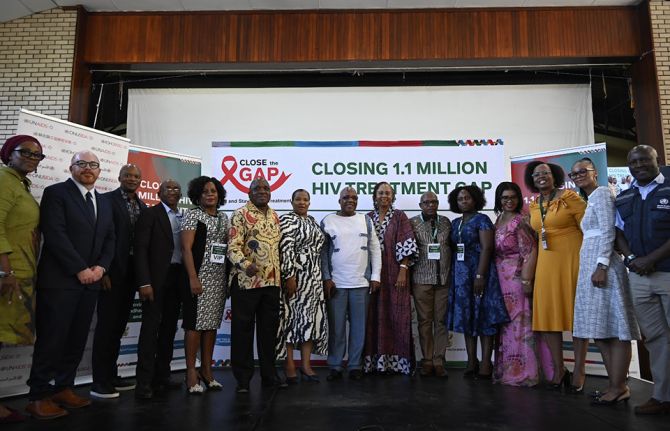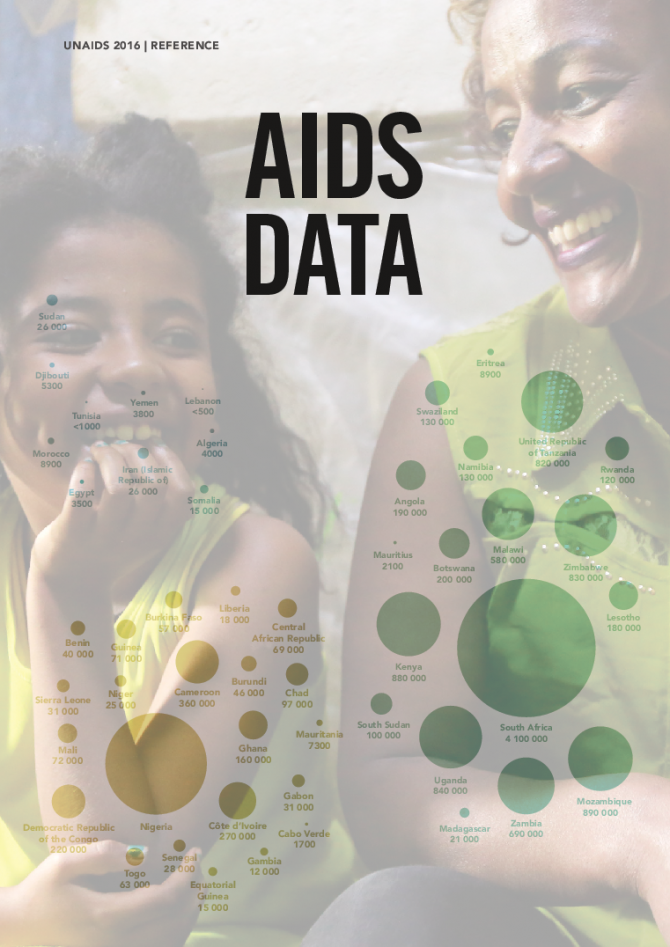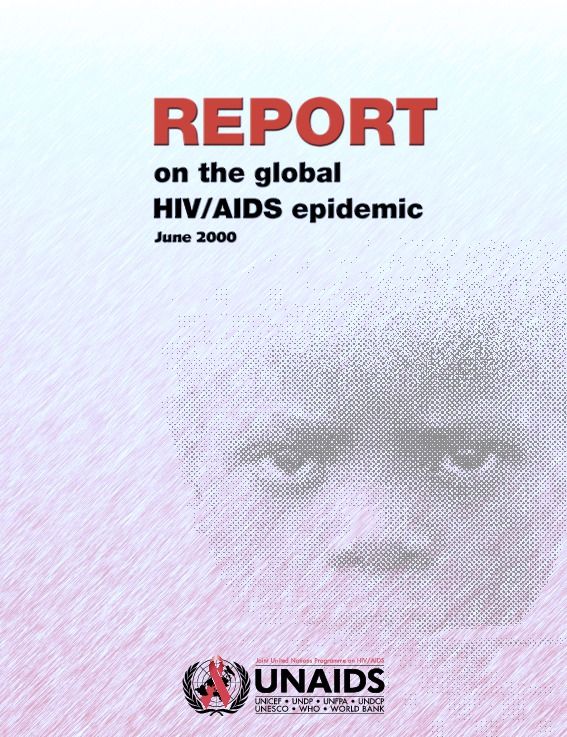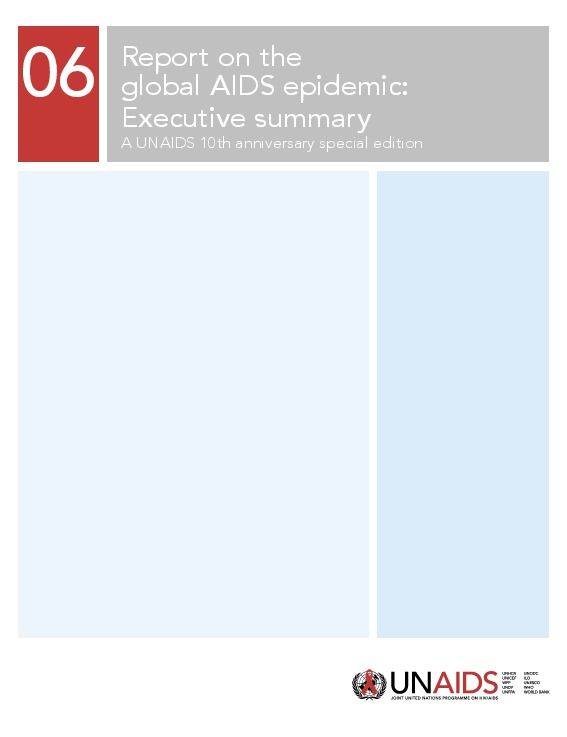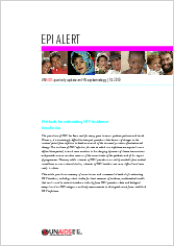Documents
2021 UNAIDS Global AIDS Update — Confronting inequalities — Lessons for pandemic responses from 40 years of AIDS
14 July 2021
UNAIDS report shows that people living with HIV face a double jeopardy, HIV and COVID-19, while key populations and children continue to be left behind in access to HIV services. Read the press release | Data slides | This document is also available in Arabic
Related
What the data tell us: Projections for the HIV epidemic in western and central Europe and North America in 2030
28 March 2025
What the data tell us: Projections for the HIV epidemic in the Middle East and North Africa in 2030
28 March 2025
What the data tell us: Projections for the HIV epidemic in eastern Europe and central Asia in 2030
28 March 2025
What the data tell us: Projections for the HIV epidemic in Asia and the Pacific in 2030
28 March 2025
What the data tell us: Projections for the HIV epidemic in western and central Africa in 2030
28 March 2025
Related
What the data tell us: Projections for the HIV epidemic in western and central Europe and North America in 2030
28 March 2025
What the data tell us: Projections for the HIV epidemic in the Middle East and North Africa in 2030
28 March 2025
What the data tell us: Projections for the HIV epidemic in eastern Europe and central Asia in 2030
28 March 2025
What the data tell us: Projections for the HIV epidemic in Asia and the Pacific in 2030
28 March 2025
What the data tell us: Projections for the HIV epidemic in western and central Africa in 2030
28 March 2025
What the data tell us: Projections for the HIV epidemic in eastern and southern Africa in 2030
28 March 2025
 U=U can help end HIV stigma and discrimination. Here’s how
U=U can help end HIV stigma and discrimination. Here’s how

27 February 2025
Documents
UNAIDS DATA 2017
20 July 2017
UNAIDS has collected and published information on the state of the world’s HIV epidemic for the past 20 years. This information has shaped and guided the development of the response to HIV in regions, countries and cities worldwide. This edition of UNAIDS data contains the highlights of the very latest data on the world’s response to HIV, consolidating a small part of the huge volume of data collected, analysed and refined by UNAIDS over the years.
Related
What the data tell us: Projections for the HIV epidemic in western and central Europe and North America in 2030
28 March 2025
What the data tell us: Projections for the HIV epidemic in the Middle East and North Africa in 2030
28 March 2025
What the data tell us: Projections for the HIV epidemic in eastern Europe and central Asia in 2030
28 March 2025
What the data tell us: Projections for the HIV epidemic in Asia and the Pacific in 2030
28 March 2025
What the data tell us: Projections for the HIV epidemic in western and central Africa in 2030
28 March 2025
Documents
AIDS data
02 May 2017
The old saying “What gets measured gets done” may be a cliché, but is still very true for the response to HIV. Over the years, a detailed understanding of the HIV epidemic has emerged through the collection, analysis and dissemination of data, helping programmes to reach the right people in the right place and at the right time. Having high-quality data on the AIDS response has enabled ambitious, measurable and time-bound targets to be set for tracking progress and ensuring accountability.
Related
What the data tell us: Projections for the HIV epidemic in western and central Europe and North America in 2030
28 March 2025
What the data tell us: Projections for the HIV epidemic in the Middle East and North Africa in 2030
28 March 2025
What the data tell us: Projections for the HIV epidemic in eastern Europe and central Asia in 2030
28 March 2025
What the data tell us: Projections for the HIV epidemic in Asia and the Pacific in 2030
28 March 2025
What the data tell us: Projections for the HIV epidemic in western and central Africa in 2030
28 March 2025
What the data tell us: Projections for the HIV epidemic in eastern and southern Africa in 2030
28 March 2025
 U=U can help end HIV stigma and discrimination. Here’s how
U=U can help end HIV stigma and discrimination. Here’s how

27 February 2025

Press Release
UNAIDS report shows that 19 million of the 35 million people living with HIV today do not know that they have the virus
16 July 2014 16 July 2014In sub-Saharan Africa, nearly 90% of people who know their HIV-positive status are on treatment—ending the AIDS epidemic by 2030 will require smart scale-up to close the gap
GENEVA, 16 July 2014—A new report by UNAIDS shows that 19 million of the 35 million people living with HIV globally do not know their HIV-positive status.
“Whether you live or die should not depend on access to an HIV test,” said Michel Sidibé, Executive Director of UNAIDS. “Smarter scale-up is needed to close the gap between people who know their HIV status and people who don’t, people who can get services and people who can’t and people who are protected and people who are punished.”
The UNAIDS Gap report shows that as people find out their HIV-positive status they will seek life-saving treatment. In sub-Saharan Africa, almost 90% of people who tested positive for HIV went on to access antiretroviral therapy (ART). Research shows that in sub-Saharan Africa, 76% of people on ART have achieved viral suppression, whereby they are unlikely to transmit the virus to their sexual partners. New data analysis demonstrates that for every 10% increase in treatment coverage there is a 1% decline in the percentage of new infections among people living with HIV.
The report highlights that efforts to increase access to ART are working. In 2013, an additional 2.3 million people gained access to the life-saving medicines. This brings the global number of people accessing ART to nearly 13 million by the end of 2013. Based on past scale-up, UNAIDS projects that as of July 2014 as many as 13 950 296 people were accessing ART.
“If we accelerate all HIV scale-up by 2020, we will be on track to end the epidemic by 2030,” said Mr Sidibé. “If not, we risk significantly increasing the time it would take—adding a decade, if not more.”
By ending the epidemic by 2030, the world would avert 18 million new HIV infections and 11.2 million AIDS-related deaths between 2013 and 2030.
Ending the AIDS epidemic
The report reveals that just 15 countries* account for more than 75% of the 2.1 million new HIV infections that occurred in 2013. In every region of the world the report finds that there are three or four countries that bear the burden of the epidemic. In sub-Saharan Africa, just three countries—Nigeria, South Africa and Uganda—account for 48% of all new HIV infections.
However, the report also shows that entire countries are being left behind—for example, six nations—Central African Republic, Democratic Republic of the Congo, Indonesia, Nigeria, Russian Federation and South Sudan—are facing the triple threat of high HIV burden, low treatment coverage and no or little decline in new HIV infections.
In the first report of its kind, the UNAIDS Gap report emphasizes the importance of location and population through an in-depth regional analysis of HIV epidemics and through analysis of 12 populations at higher risk of HIV. It analyses the reasons for the widening gap between people gaining access to HIV prevention, treatment, care and support, and people being left behind. It shows how focusing on populations that are underserved and at higher risk of HIV will be key to ending the AIDS epidemic.
HIV prevalence is estimated to be 28 times higher among people who inject drugs, 12 times higher among sex workers, 19 times higher among gay men and other men who have sex with men and up to 49 times higher among transgender women than among the rest of the adult population. In sub-Saharan Africa, adolescent girls and young women account for one in four new HIV infections. The report looks at why certain populations are not accessing HIV services and outlines the urgent need to address their specific needs.
“There will be no ending AIDS without putting people first, without ensuring that people living with and affected by the epidemic are part of a new movement,” said Mr Sidibé. “Without a people-centred approach, we will not go far in the post-2015 era.”
The report shows that it is both essential and possible to go deeper than a country-wide approach. Because countries and regions have multiple and varying epidemics, the report outlines that having country targets and sound policies in place creates space to address complex micro-epidemics with tailored, bite-sized solutions that will help reach people faster with better HIV services. It notes that cities and communities will play an increasingly major role in effective scale-up.
However, the report also shows that a lack of data on people most affected by HIV, coupled with widespread stigma and discrimination, punitive legal environments, barriers to civil society engagement and lack of investment in tailored programmes are holding back results. It confirms that countries that ignore discrimination and condone inequalities will not reach their full potential, and face serious public health and financial consequences of inaction. The report emphasizes the need for equal access to quality HIV services as both a human rights and public health imperative.
Hope and gaps
UNAIDS is reporting the lowest levels of new HIV infections this century, at 2.1 million [1.9 million–2.4 million]. In the last three years alone new HIV infections have fallen by 13%.
It is estimated that 35 million people were living with HIV in the world at the end of 2013. AIDS-related deaths are at their lowest since the peak in 2005, having declined by 35%. Tuberculosis continues to be the leading cause of death among people living with HIV.
New HIV infections among children have fallen by 58% since 2001 and dropped below 200 000 for the first time in the 21 most affected countries in Africa.
The highest number of people living with HIV was in sub-Saharan Africa—24.7 million [23.5 million–26.1 million] people. Asia and the Pacific had the next largest population of people living with HIV, at an estimated 4.8 million [4.1 million–5.5 million] people.
The percentage of people living with HIV who were receiving treatment was found to be highest in western Europe and North America, at 51% [39–60%], and in Latin America, at 45% [33–51%]. However, coverage was lowest in the Middle East and North Africa, at just 11% [8–16%].
New HIV infections declined most in the Caribbean—by 40% since 2005; however, new HIV infections have risen by 7% in the Middle East and North Africa and by 5% in eastern Europe and central Asia since 2005.
AIDS-related deaths were seen to be rising steeply in the Middle East and North Africa, by 66%. The only other region where AIDS-related deaths are increasing is eastern Europe and central Asia, where AIDS-related deaths rose by 5% between 2005 and 2013.
The report outlines that to close the gap between people who are reached with HIV services and people who are not will require research and innovation combined with protective laws that promote freedom and equality for all people. It will also require increased commitment from the global community and countries most affected to the remarkable returns on investment that have been witnessed over the last 10 years to continue so that the end of the AIDS epidemic can be achieved by 2030.
UNAIDS is providing video footage (broll and video news release) for broadcasters, as well as excerpts from the report launch press conference. http://www.unaids.org/en/resources/campaigns/2014/2014gapreport/videofootage/
*Brazil, Cameroon, China, India, Indonesia, Kenya, Mozambique, Nigeria, Russian Federation, South Africa, Uganda, United Republic of Tanzania, USA, Zambia, Zimbabwe.
UNAIDS
The Joint United Nations Programme on HIV/AIDS (UNAIDS) leads and inspires the world to achieve its shared vision of zero new HIV infections, zero discrimination and zero AIDS-related deaths. UNAIDS unites the efforts of 11 UN organizations—UNHCR, UNICEF, WFP, UNDP, UNFPA, UNODC, UN Women, ILO, UNESCO, WHO and the World Bank—and works closely with global and national partners towards ending the AIDS epidemic by 2030 as part of the Sustainable Development Goals. Learn more at unaids.org and connect with us on Facebook, Twitter, Instagram and YouTube.
Related
What the data tell us: Projections for the HIV epidemic in western and central Europe and North America in 2030
28 March 2025
What the data tell us: Projections for the HIV epidemic in the Middle East and North Africa in 2030
28 March 2025
What the data tell us: Projections for the HIV epidemic in eastern Europe and central Asia in 2030
28 March 2025
What the data tell us: Projections for the HIV epidemic in Asia and the Pacific in 2030
28 March 2025
What the data tell us: Projections for the HIV epidemic in western and central Africa in 2030
28 March 2025
Documents
Report on the global AIDS epidemic: Executive summary
16 May 2006
Related
What the data tell us: Projections for the HIV epidemic in western and central Europe and North America in 2030
28 March 2025
What the data tell us: Projections for the HIV epidemic in the Middle East and North Africa in 2030
28 March 2025
What the data tell us: Projections for the HIV epidemic in eastern Europe and central Asia in 2030
28 March 2025
What the data tell us: Projections for the HIV epidemic in Asia and the Pacific in 2030
28 March 2025
What the data tell us: Projections for the HIV epidemic in western and central Africa in 2030
28 March 2025
Documents
Executive summary of 2008 Report on the global AIDS epidemic
17 July 2008
The report documents considerable progress in many countries in addressing their national epidemics. A six fold increase in financing for HIV programmes in low- and middle-income countries 2001–2007 is beginning to bear fruit, as gains in lowering the number of AIDS deaths and preventing new infections are apparent in many countries. Progress remainsuneven, however, and the epidemic’s future is still uncertain, underscoring the need for intensified action to move towards universal access to HIV prevention, treatment, care and support.
Related
What the data tell us: Projections for the HIV epidemic in western and central Europe and North America in 2030
28 March 2025
What the data tell us: Projections for the HIV epidemic in the Middle East and North Africa in 2030
28 March 2025
What the data tell us: Projections for the HIV epidemic in eastern Europe and central Asia in 2030
28 March 2025
What the data tell us: Projections for the HIV epidemic in Asia and the Pacific in 2030
28 March 2025
What the data tell us: Projections for the HIV epidemic in western and central Africa in 2030
28 March 2025
Documents
Methods for estimating HIV incidence
16 June 2010
This article provides a summary of current issues and recommended methods for estimating HIV incidence, including cohort studies for direct measures of incidence, mathematical models that can be used to estimate incidence indirectly from HIV prevalence data and biological assays based on HIV antigen or antibody measurements to distinguish recent from established HIV infections.
Related
Indicators and questions for monitoring progress on the 2021 Political Declaration on HIV and AIDS — Global AIDS Monitoring 2025
17 December 2024
Presentation: 2025 Global AIDS Monitoring
17 December 2024
UNAIDS data 2024
02 December 2024
Slide deck - 2024 global AIDS update
22 July 2024
Core epidemiology slides
22 July 2024

